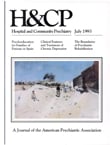Long-Term High-Dose Neuroleptic Treatment: Who Gets It and Why?
Abstract
Objective: High doses of neuroleptic medication are still administered to many patients, although many studies have shown the effectiveness of low-dose strategies. The purposes of the study was to determine whether and in what ways high-dose patients differed from patients on regular dosages and whether the higher dosages were more effective. Methods: In a case-control study at two large state hospitals, 38 high-dose patients were compared with 29 regular-dose patients. Results: The high-dose patients had a persistent course of illness, with severe chronic symptoms resulting in hospitalizations of much longer duration than those of the regular-dose patients. The high-dose patients evidenced more regressed functioning and were more violent. To control these behaviors, clinicians increased neuroleptic dosages. Conclusions: The high-dose patients represented a subgroup of chronic regressed and violent patients. Clinicians prescribed high dosages and continued to use them despite a lack of clear evidence that such treatment is effective.
Access content
To read the fulltext, please use one of the options below to sign in or purchase access.- Personal login
- Institutional Login
- Sign in via OpenAthens
- Register for access
-
Please login/register if you wish to pair your device and check access availability.
Not a subscriber?
PsychiatryOnline subscription options offer access to the DSM-5 library, books, journals, CME, and patient resources. This all-in-one virtual library provides psychiatrists and mental health professionals with key resources for diagnosis, treatment, research, and professional development.
Need more help? PsychiatryOnline Customer Service may be reached by emailing [email protected] or by calling 800-368-5777 (in the U.S.) or 703-907-7322 (outside the U.S.).



